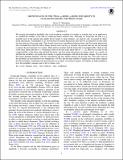GROWTH RATE OF THE TIDAL p-MODE g-MODE INSTABILITY IN COALESCING BINARY NEUTRON STARS
Author(s)
Weinberg, Nevin N.
DownloadWeinberg-2016-GROWTH RATE OF THE T.pdf (3.002Mb)
PUBLISHER_POLICY
Publisher Policy
Article is made available in accordance with the publisher's policy and may be subject to US copyright law. Please refer to the publisher's site for terms of use.
Terms of use
Metadata
Show full item recordAbstract
We recently described an instability due to the nonlinear coupling of p-modes to g-modes and, as an application, we studied the stability of the tide in coalescing binary neutron stars. Although we found that the tide is p–g unstable early in the inspiral and rapidly drives modes to large energies, our analysis only accounted for three-mode interactions. Venumadhav et al. showed that four-mode interactions must also be accounted for as they enter into the analysis at the same order. They found a near-exact cancellation between three- and four-mode interactions and concluded that while the tide in binary neutron stars can be p–g unstable, the growth rates are not fast enough to impact the gravitational wave signal. Their analysis assumes that the linear tide is incompressible, which is true of the static linear tide (the m = 0 harmonic) but not the non-static linear tide (m = ±2). Here we account for the compressibility of the linear tide and find that three- and four-mode interactions no longer cancel. As a result, we find that the instability can rapidly drive modes to significant energies well before the binary merges. We also show that linear damping interferes with the cancellation and may further enhance the growth rates. The early onset of the instability (at gravitational wave frequencies ≈50 Hz) and the large number of rapidly growing modes suggest that the instability could impact the gravitational wave signal. Assessing its impact will require an understanding of how the instability saturates and is left to future work.
Date issued
2016-03Department
Massachusetts Institute of Technology. Department of PhysicsJournal
Astrophysical Journal
Publisher
IOP Publishing
Citation
Weinberg, Nevin N. “GROWTH RATE OF THE TIDALp-MODEg-MODE INSTABILITY IN COALESCING BINARY NEUTRON STARS.” The Astrophysical Journal 819, no. 2 (March 3, 2016): 109. © 2016 The American Astronomical Society
Version: Final published version
ISSN
1538-4357
0004-637X